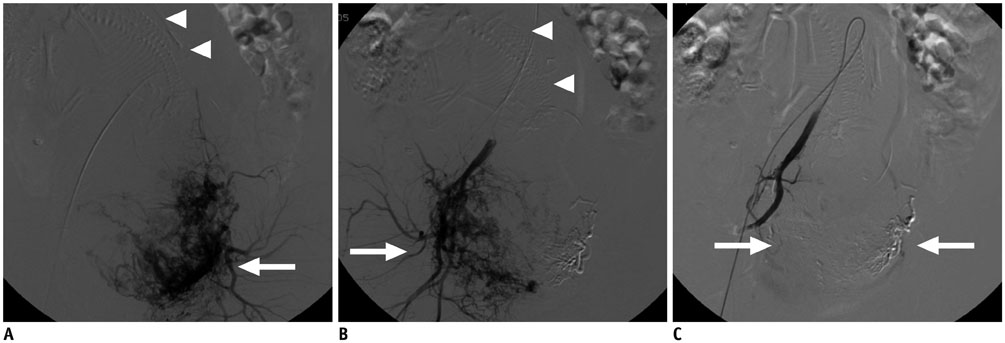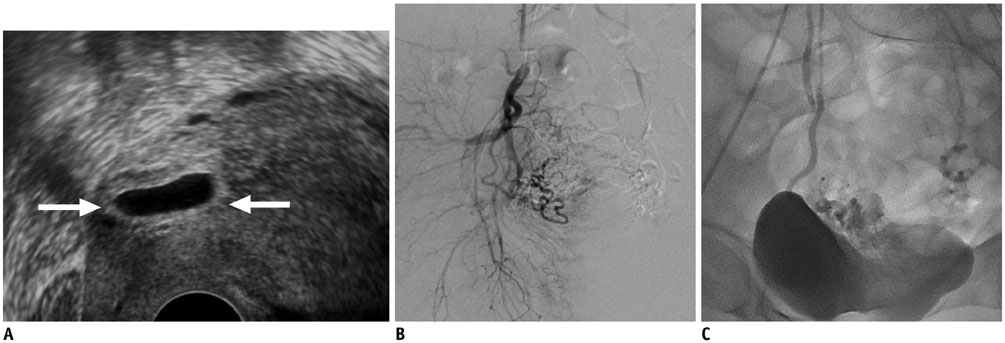Korean J Radiol.
2017 Apr;18(2):355-360. 10.3348/kjr.2017.18.2.355.
Efficacy of Prophylactic Uterine Artery Embolization before Obstetrical Procedures with High Risk for Massive Bleeding
- Affiliations
-
- 1Department of Radiology, Asan Medical Center, Ulsan University College of Medicine, Seoul 05505, Korea. jhshin@amc.seoul.kr
- 2Department of Obstetrics and Gynecology, Asan Medical Center, Ulsan University College of Medicine, Seoul 05505, Korea.
- KMID: 2427947
- DOI: http://doi.org/10.3348/kjr.2017.18.2.355
Abstract
OBJECTIVE
To evaluate the safety and efficacy of prophylactic uterine artery embolization (UAE) before obstetrical procedures with high risk for massive bleeding.
MATERIALS AND METHODS
A retrospective review of 29 female patients who underwent prophylactic UAE from June 2009 to February 2014 was performed. Indications for prophylactic UAE were as follows: dilatation and curettage (D&C) associated with ectopic pregnancy (cesarean scar pregnancy, n = 9; cervical pregnancy, n = 6), termination of pregnancy with abnormal placentation (placenta previa, n = 8), D&C for retained placenta with vascularity (n = 5), and D&C for suspected gestational trophoblastic disease (n = 1). Their medical records were reviewed to evaluate the safety and efficacy of UAE.
RESULTS
All women received successful bilateral prophylactic UAE followed by D&C with preservation of the uterus. In all patients, UAE followed by obstetrical procedure prevented significant vaginal bleeding on gynecologic examination. There was no major complication related to UAE. Vaginal spotting continued for 3 months in three cases. Although oligomenorrhea continued for six months in one patient, normal menstruation resumed in all patients afterwards. During follow-up, four had subsequent successful natural pregnancies. Spontaneous abortion occurred in one of them during the first trimester.
CONCLUSION
Prophylactic UAE before an obstetrical procedure in patients with high risk of bleeding or symptomatic bleeding may be a safe and effective way to manage or prevent serious bleeding, especially for women who wish to preserve their fertility.
MeSH Terms
Figure
Cited by 1 articles
-
Recent Update of Embolization of Postpartum Hemorrhage
Chengshi Chen, Sang Min Lee, Jong Woo Kim, Ji Hoon Shin
Korean J Radiol. 2018;19(4):585-596. doi: 10.3348/kjr.2018.19.4.585.
Reference
-
1. De Sutter TC, Lohle PN, Boekkooi PF. [Severe blood loss days after suction and curettage: consider a pseudoaneurysm]. Ned Tijdschr Geneeskd. 2013; 157:A6004.2. Bartlett LA, Berg CJ, Shulman HB, Zane SB, Green CA, Whitehead S, et al. Risk factors for legal induced abortion-related mortality in the United States. Obstet Gynecol. 2004; 103:729–737.3. Kerns J, Steinauer J. Management of postabortion hemorrhage: release date November 2012 SFP Guideline #20131. Contraception. 2013; 87:331–342.4. Zhuang Y, Huang L. Uterine artery embolization compared with methotrexate for the management of pregnancy implanted within a cesarean scar. Am J Obstet Gynecol. 2009; 201:152.e1–152.e3.5. Wang JH, Qian ZD, Zhuang YL, Du YJ, Zhu LH, Huang LL. Risk factors for intraoperative hemorrhage at evacuation of a cesarean scar pregnancy following uterine artery embolization. Int J Gynaecol Obstet. 2013; 123:240–243.6. Steinauer JE, Diedrich JT, Wilson MW, Darney PD, Vargas JE, Drey EA. Uterine artery embolization in postabortion hemorrhage. Obstet Gynecol. 2008; 111:881–889.7. Izbizky G, Meller C, Grasso M, Velazco A, Peralta O, Otaño L, et al. Feasibility and safety of prophylactic uterine artery catheterization and embolization in the management of placenta accreta. J Vasc Interv Radiol. 2015; 26:162–169. quiz 170.8. Le Gall J, Fichez A, Lamblin G, Philip CA, Huissoud C. [Cesarean scar ectopic pregnancies: combined modality therapies with uterine artery embolization before surgical procedure]. Gynecol Obstet Fertil. 2015; 43:191–199.9. Grimes DA, Flock ML, Schulz KF, Cates W Jr. Hysterectomy as treatment for complications of legal abortion. Obstet Gynecol. 1984; 63:457–462.10. Warshak CR, Eskander R, Hull AD, Scioscia AL, Mattrey RF, Benirschke K, et al. Accuracy of ultrasonography and magnetic resonance imaging in the diagnosis of placenta accreta. Obstet Gynecol. 2006; 108(3 Pt 1):573–581.11. Borgatta L, Chen AY, Reid SK, Stubblefield PG, Christensen DD, Rashbaum WK. Pelvic embolization for treatment of hemorrhage related to spontaneous and induced abortion. Am J Obstet Gynecol. 2001; 185:530–536.12. Haddad L, Delli-Bovi L. Uterine artery embolization to treat hemorrhage following second-trimester abortion by dilatation and surgical evacuation. Contraception. 2009; 79:452–455.13. Godfrey CD, Zbella EA. Uterine necrosis after uterine artery embolization for leiomyoma. Obstet Gynecol. 2001; 98(5 Pt 2):950–952.14. Cottier JP, Fignon A, Tranquart F, Herbreteau D. Uterine necrosis after arterial embolization for postpartum hemorrhage. Obstet Gynecol. 2002; 100(5 Pt 2):1074–1077.15. Hong TM, Tseng HS, Lee RC, Wang JH, Chang CY. Uterine artery embolization: an effective treatment for intractable obstetric haemorrhage. Clin Radiol. 2004; 59:96–101.
- Full Text Links
- Actions
-
Cited
- CITED
-
- Close
- Share
- Similar articles
-
- Laparoscopic uterine artery occlusion before cervical curettage in cervical ectopic pregnancy: Safe and effective for preventing massive bleeding
- Postpartum Bleeding: Efficacy of Endovascular Management
- A Case using Uterine Artery Embolization for the Patient with Uterine Artery Bleeding after Transobturator Tape Operation
- Spontaneous Uterine Rupture after Uterine Artery Embolization for the Treatment of Uterine Myomas
- Uterine Artery Embolization as an Effective Management and Diagnostic Tool for Puerperal Uterine Inversion with Severe Postpartum Bleeding: A Case Report




